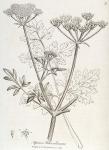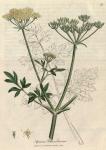
 Synonyma. Petroselinum. Pharm. Lond. & Edinb.
Synonyma. Petroselinum. Pharm. Lond. & Edinb.
Apium hortense vulgo Petroselinum. Bauh. Pin. p. 153.
Petroselinum vulgare. Park. Theat. p. 922.
Apium hortense. Gerard. Emac. p. 1013. Raii. Hist. p. 1448.
α Apium sativum. Riv. pent. 88. Common Parsley.
β Apium crispum. Riv. pent. 90. Curled Parsley.
γ Apium radice esculenta. Hort. Ups. 67. Large rooted Parsley. Aiton's Hort. Kew.
Class Pentandria. Ord. Digynia. Lin. Gen. Plant. 367.
Ess. Gen. Ch. Fructus ovatus, striatus. Involucrum 1-phyllum. Petala aequalia.
Spec. Char. A. foliolis caulinis linearibus, involucellis minutis.
The root is biennial, long, white, and beset with fibres: the stem is upright, round, scored, branched, jointed, and usually rises two feet in height: the radical leaves are with footstalks, compound, pinnated in ternaries: the leafits are smooth, veined, divided into three lobes, and notched at the margin: the leaves of the stalk proceed from the vaginal sheaths at the joints, and have the leafits cut into narrow linear entire segments: the flowers are small, of a yellow colour, and terminate the stem and branches in umbels composed of general and partial radii; the former are about ten in number, and the latter twenty in each umbel; it seldom has a general involucrum, but the partial involucrum consists of six or eight leafits, unequal, pointed, spreading, and shorter than the umbel: the corolla consists of five oval petals, which have their points inflected: the filaments are five, spreading, slender, twice the length of the corolla, and crowned with roundish antherae: the germen is oval, striated, and supports two short reflected styles, terminated with obtuse stigmata: the seeds are of a dark green colour, oblong, angular, striated, flat on one side, and convex on the other. It is a native of Sardinia, and flowers in June and July.
All the varieties of Parsley have been long very generally cultivated in England, [Cultivated in 1551. Turn. Herb. part. I. sign. D iiii. Vide Aiton's Hort. Kew.] and its frequent use for culinary purposes renders it more familiar than most of the plants which our kitchen gardens produce. Both the roots and seeds of Parsley are directed by the London College for medicinal use; the former have a sweetish taste, accompanied with a slight warmth or flavour, somewhat resembling that of a carrot: the latter are in taste warmer, and more aromatic than any other part of the plant, and also manifest considerable bitterness. In distillation, three pounds yielded above an ounce of essential oil, a great part of which sunk in the fluid. They give out little of their qualities by infusion in watery menstrua, but readily impart all their virtue to rectified spirit. The roots, by distillation in water, were found to yield a very considerable portion of essential oil, not above two or three drams from as many hundred pounds of the root. [Lewis, Mat. Med. p. 499.] These roots are said to be aperient and diuretic, and have been employed in apozems, to relieve nephritic pains, and obstructions of urine. [See Hoffman and others.] In this way they have been prescribed by Dr. Cullen without producing any diuretic effect, and this he thinks may in some measure be attributed to the loss of their active matter, which they sustain in boiling. [Mat. Med. p. 159.] The seeds, like those of many other umbelliferous plants, possess a share of aromatic and carminative power; but as this is inconsiderable they are now seldom employed. [Externally they have been advantageously used for destroying cutaneous insects in children. Vide Con. Mich. Valentini Act. Nat. Cur. vol. i. p. 285. and Rosenstein Barns junkd. Ed. 3. p. 533.] The bruised leaves have been successfully used as a decutient poultice to various kinds of tumours. [We are told by Lange, (Misc. verit. med. p. 26) that this application has succeeded in scirrhous tumours where Cicuta and Mercury had failed.] Although Parsley is so commonly used at table, it is remarkable that facts have been adduced to prove that in some constitutions it occasions epilepsy, or at least aggravates the epileptic fits in those who are subject to this disease. [Hannemannus, in Eph. Nat. Cur. Dec. 3. A. 3. p. 78. And Marriotte in Journ. de Med. t. 23. p. 545.] It has been supposed also to produce inflammation in the eyes. [See Boyle's Works, t. 1. p. 503. Alston's Lect. on M. M. vol. i. p. 381. And cited by Murray.]

